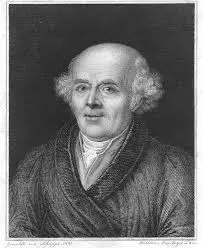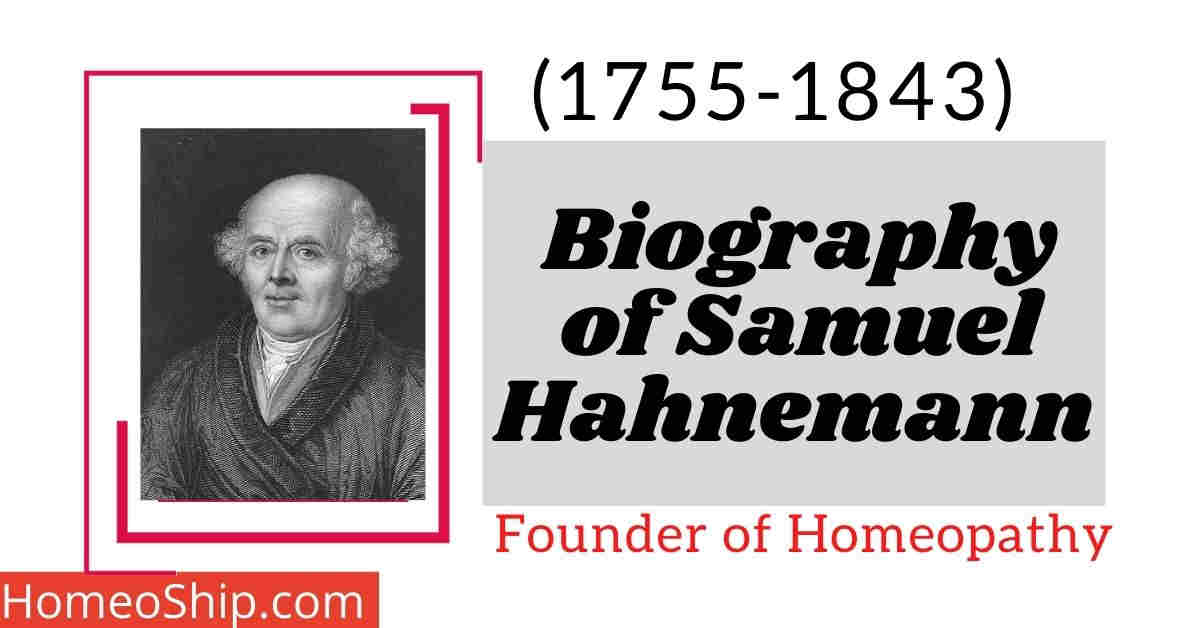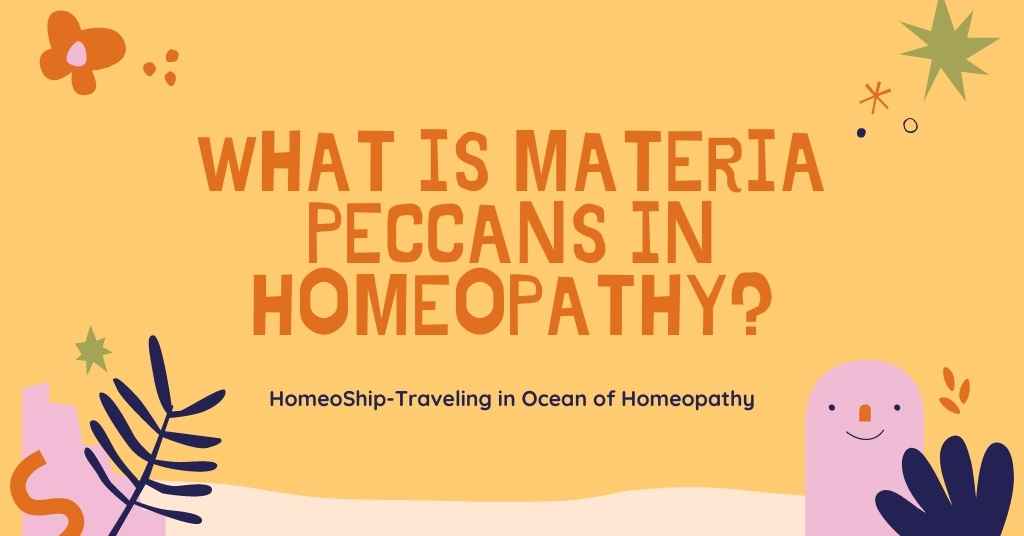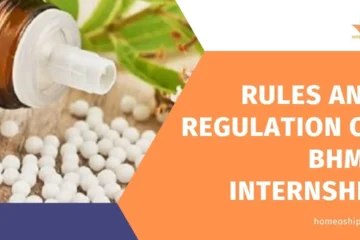Contents
Dr.Samuel Christian Gottfried Frederick Hahnemann
was born on 10 April 1755. In Meissen near Dresden in Germany in the state of Saxony. He was the third child of his parents. (father’s name was Christian Gottfried Hahnemann and his Mother’s name was Johanna Christina Spiess).
Samuel Hahnemann as the life of many men was has become popular and has achieved something that shows that they have done this under the most unfavorable circumstances & despite the greatest obstacles. In the same way, Dr. Hahnemann’s life was also the same. Dr. Hahnemann’s father was an industrious but fortune-less painter on porcelain, in a factory in Miessen.
He had a great influence on the character of his son (Master Hanemann); by his independent judgment in all cases and not to take anything for granted or on trust, but in every case act as reasoning told by him was the best. This character of Dr. Hahnemann was introduced to his father and by which he always profited.
Dr. Hahnemann was admitted to the town school of Meissen at a very late age at about 12 years of age. Dr. Hahnemann’s father was not ready to admit school but notwithstanding his father’s prohibition, Dr. Hahnemann went to school.
Later on, he went to Prince’s school in November 1770 because of his aptitude for Studies, he gained the admiration of school teachers especially Master Muller with whom he became a favorite student and who undertook to help him and directed his studies.
he gained the admiration of school teachers especially Master Muller with whom he became a favorite student and who undertook to help him and directed his studies.
He also encouraged Dr.Hahnemann to higher orders of studies in school. Dr. Hahnemann took much interest in the study of Botany, Mathematics, and Geometry, and above all. He was interested in the study of languages, but his father was too poor to provide education to him, so he sent him to work in a grocery shop in Leipzig but against his father wished.
Dr. Hahnemann returned to Meissen and continued his studies. He was a brilliant student, who was able to complete the study within a short span.
In 1775 he left the school and on leaving school it was the custom to write an essay on some subject. Dr. Hahnemann selected an unusual subject of “The wonderful structure of the human hand”
20 years old and 20 thalers,
in his pocket and blessing of his father, he left for Leipzig from Meissen where he wanted to study medicine. During that time he manages to support himself by teaching French, German and by translating books from English. At that young age, Hahnemann has sound knowledge of 8 languages. But soon he left Leipzig and went to Vienna, which had better hospital facilities, and entered the famous hospital known as Brother’s of Mercy then he was fortunate enough to secure the knowledge of Dr. Von Quarin a renowned physician who treated him like a son.

Completion of Masters
In 1779 at the age of 24 years after much hardship and struggle, he got his medical degree of M.D. from the University of Erlangen on his thesis “A Consideration of the Etiology and Therapeutics of Spasmodic Affection”. Meanwhile, to sustain himself, he was forced to accept the post of Liberian as well as the family physician to the governor of Transylvania. Due to his longing, he wanted to go to his fatherland. He wanted to practice in Heested, which was a copper mining town, but there was no scope of practice in the small town.
After 9 months in 1781, he left for Dessau which was about 50km away from Heested. During this time his work of writing had continued as well as his reading interest. When he shifted to Dessau, his writing was published in Kreb’s Medical Observation. Through his writings as well as because of his work of translation of the medical book his name became known in the medical world. In Dessau, he first turned his attention to Chemistry.
This interest in chemistry brought him in contact with Mr.Haesler a Chemist. Dr.Hahnemann and Mr.Haesler had a common interest in Chemistry and they worked together, to share their common interest.
His stepdaughter Johanna Leopoldine Kennel Kuchler met Dr.Hahnemann and soon Dr.Hahnemann married Hennette who was 9 years junior to him on 17 Nov. 1781.
During this time he was appointed as district physician in Gommem. Here also he wrote his first book on Medicine in which he confidently admitted that most of his patients would have done better.
During this year 1785 to 1799, the versatile author and translator had more than 2300 printed pages to his credit of translation and his writing consists of 4700 printed pages.
He had become very popular and his translation of French chemist “Demachy’s’ book “The Wholesale Manufacture of Chemical Products in Factories” in two-volume made him a highly valued translator which was possible due to his knowledge of Chemistry and Languages.
By 1789 Dr.Hahnemann moved to Leipzig. Here its first volume of “Friend of Health” was published. Along with this, he published many chemical words. The most celebrated of which is a “Treatise upon Poisoning by Arsenic”, which is called to this day as an authority by the best writer of toxicology.
Dr.Hahnemann was not much satisfied with the system of medicine, so he leans more towards chemistry and literature.
He made considerable progress in his work of chemistry and his valuable for ascertaining the “Purity of Alcohol” is a testimony. In 1789 he published his book “Treatise of Syphilis”. This work is chiefly remarkable for its discovery and description of “Dew Preparations of Mercury” which is to this day known as “Hahnemann’s Soluble Mercury”. He also gave some very different views on the “Treatment of Syphilis”.
Born of Homeopath
In 1790 he started the translation of William Cullen’s “Materia Medica” known as Treaties to Materia Medica from English to German and found the explanation of the antipyretic power of “Cinchona Bark” which was popularly known as Quinine. The effectiveness of Cinchona Bark for the cure of/ague fever was explained, but this explanation did not satisfy Dr.Hahnemann. This episode in Dr.Hahnemann’s life was just like the falling of an apple in Newton’s life or the swinging of the lamp in the church of Pisa in the life of Galileo.

To find out the effect of Cinchona Bark he took 4 drachms of Cinchona Bark juice. He was attacked by symptoms of ague fever. When he stops taking the juice, symptoms disappear. From this experiment, he concluded that the pathogenetic effect of medicine could give a key to the therapeutic power which means drug produces simple symptoms in a healthy person to that they cure in a sick person.
For a further six years from 1790 to 1796, he experimented with more drugs with relatives and friends, and by this, his conviction was further justified.
In 1796 he published his discovery in an article titled “An Essay on a New Principle for Ascertaining Curative Power of Drug”. Therefore 1796 is considered the birth year of Homoeopathy. On the other hand, poverty increases with increasing families take charge as an asylum för insane in Georgenthal in the Thuringian. Here he was the first to advocate mildness in the treatment of the insane and to prohibited physical torture, which later on is accepted by the world.
From here Dr.Hahněmann traveled a lot and shifted to different places to earn his living. He stayed in Kongslutter till 1799.
In this interval, he published the 2nd part of the book “Friend of Health”. Between the years 1790 to 1805 Dr. Hahnemann’s writings on translation increases and it consisted of about 5500 pages. In the year 1805 his book “Medicine of Experience” was published, which was the 1st important book, describing the science and practice of Homeopathy.
Bible of Homeopathy
After that in the year 1810 Dr.Hahnemann’s Bible of Homoeopathy i.e. “Organon of Rational Art of Healing” was published which for the first time described in detail the system of medicine called Homoeopathy.
But the publication of this book was the signal for the commencement of violent war comes against Dr.Hahnemann.
Criticism
Allopathic and Pharmacist attacked him very severely. Many books, Journals, Pamphlets, and Articles were published against him, his disciples, and a new system of Homoeopathy. He was criticized and abused in the articles in foul language. His disciples were protested and were not allowed to use Homoeopathic Medicine.
Dr.Hahnemann himself was also prohibited from using Homoeopathic Medicine for dispensing his own medicines.
During this period of his life, he faced lots of opposition not only from his fellow physician but even from some of his good friends. People tried to discourage him in the development of Homoeopathy, but he was the last person to be afraid of criticism and he continued his work on Homoeopathy and carried on with experimentation with the more new medicine.
During the last year of staying in Kongslutter, he witnessed a severe academic Scarlet Fever and he found that the children to whom he was given small doses of Belladonna were not affected by these violent diseases which were raging around. This is how he made an important discovery of the prophylactic power of Belladonna in Scarlet Fever.
In between the year 1811 to 1821, 8 volumes of “Materia Medica Pura”, which is a record of symptoms of the drugs tested on healthy human beings, were published. At the same time after much pleading, Dr.Hahnemann was allowed to deliver lectures on Homoeopathy at the University of Leipzig but later on, immediately he had to stop, due to the depressing circumstances of criticism in Leipzig, Dr.Hahnemann had to leave Leipzig with a heavy heart.
But in 1821 omits an antagonism of allopaths, pharmacists, and government officials. “Duke Ferdinand” of Anhalt in kohen permits to settle and practice Homeopathy. Here in the year 1829 the 1st & 2nd volume of his famous work on Chronic Diseases they are peculiarities and their Homoeopathy treatment were published.
On 31 March 1830, Dr.Hahnemann’s wife after nearly 48 years of marriage and the mother of his 11 children, died. She was with Dr.Hahnemann’s during the years of suffering and wondering, poverty, and unsettlement of the future, and when the period of comfort and glory began, she did not remain to enjoy it her contribution all Dr. Hahnemann’s life was immense. She had sacrificed her own comfort for the well-being of the family. She had struggled to maintain the family even with the poor source of income. Dr.Hahnemann loved and highly esteem her.
But the death of his life partner did not affect his work. Dr. Hahnemann continued with the development of Homeopathy because in the years 1829 and 1830 he published the 3rd, 4rh & 5th volumes of Chronic Diseases. Which has included the extensive and valuable proving of new medicine, the exhaustive study of the understanding and treatment of Chronic Diseases was mentioned in this publication of Chronic Diseases.
On the 10th of August 1829, a large group of his disciples and admirers got together, Assembled in kohen to celebrate the 58th anniversary of his réception of the Doctorate Degree. On that very day, Dr.Hahnemann found the First Homoeopathic Society under the name of the Central Society of German Homoeopathic, which exists, and flourishes up to this date. The same Society later erected a bronze statue of Dr.Hahnemann in Leipzig as a grateful moment to this illustrates the founder of Homoeopathy after his death in the year 1851. During this period the success of Homeopathy and the popularity of Dr.Hahnemann began to spread beyond the limit of Germany.
In 1835, Madam Marie Melaine d’Harvilly came to lo Koelhen for treatment to Dr.Hahnemann and she falls in love with the widower who was 80 years old. She was a beautiful young woman of higher society. She was 32 years old. They got married on 18th Jan 1835 and stayed in Kotlin for few years than they left Koethen and went to Paris on 7th June and reach there on 21st June 1835 to Paris. They are married, surprised by all Dr. Hahnemann’s friends and family because this step of Dr. Hahnemann did not match his habit and character and his last.
Initially in Paris, Dr.Hahnemann had let a quiet life resting and enjoying in a beautiful house away from the city but this was a very short time. Madam Melaine took a very big house in the center of the city and they started staying there, where again Dr.Hahnemann had a very busy practice as its patient he had some well “known personalities like Duke’s, Dutch’s, Kings, Queens, and even Film stars.
In Paris, Dr.Hahnemann got everything of value like recognition, owner, name, money, comfort, fame, and above all the most needed peace.
By this time the Homoeopathic Philosophy had reached Europe and America. Dr. Constantine Herring started a Homoeopathy Institution in the USA along with him well-known physician like Bradford, Richard Heald, etc. developed Homoeopathy, Dr.F.F Quin was propagating Homoeopathy in Britain. The translation of the Organon started appearing in all reputed Languages of the world.
By now Homoeopathy was set on a path of glory and prosperity as a separate and independent system of Medicine. Many Homoeopathic Institution was opened named after Dr.Hahnemann and even a Homoeopathic Hospital were started in Leipzig whose management initially had looked after Dr.Hahnemann when he was in Koethen. Homeopathy was able to practice and develop Homeopathy now without any opposition. Dr. Hahnemann serviced his migration to Paris for 8 years.
During these 8 years, he became a very busy and reputed Homoeopathic Physician. He died there full of the owner after a long tough resourceful life at the age of 89 tell his end he kept on working instead of his failing health, he had completed the manuscript of the 6th edition of Organon before he died.
Therefore his last word was “I have not lived in vain” actually shows the worthiness of Dr. Hahnemann’s life.
Rest in Peace
He died on 2 July 1843 in the early hours of the morning. He was buried in the cemetery of Montmentry and the funeral was attended by only two relatives one his daughter and his grandson Dr.Leopard Hahnemann. Very few other people have attended the funeral which was a very poor funeral for a man who has achieved so many things in his life and worked so hard to remove the suffering of mankind and who acted such an important role in the world’s history of medicine.
Even after his death his grave was not properly looked after but after about half a century of his death he was given a proper funeral and was reburied in a proper place called the cemetery of Pere-La Chase and a proper grave according to his reputation was build. Many Homoeopathic physicians attended this reburial from all over the world.
Search is the outline of Dr.Hahnemann’s labor, who will be always remembered as the founder of a new system of healing, author of many books, one who had exercised an important influence on the art of medicine.
For further reference Visit Wikipedia & want to know more about homeopathy then visit here. Comment down if we miss any major life milestones of master Hanemann.


